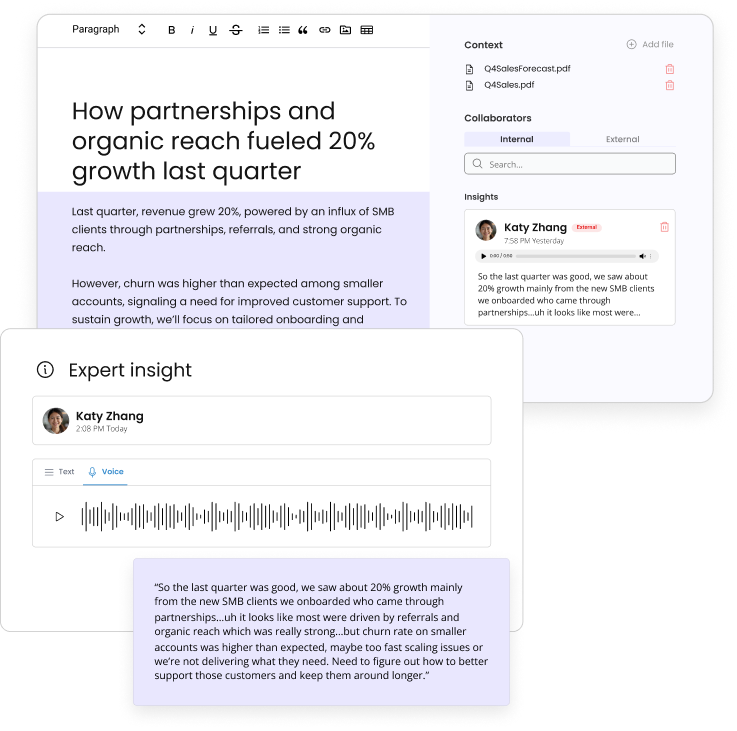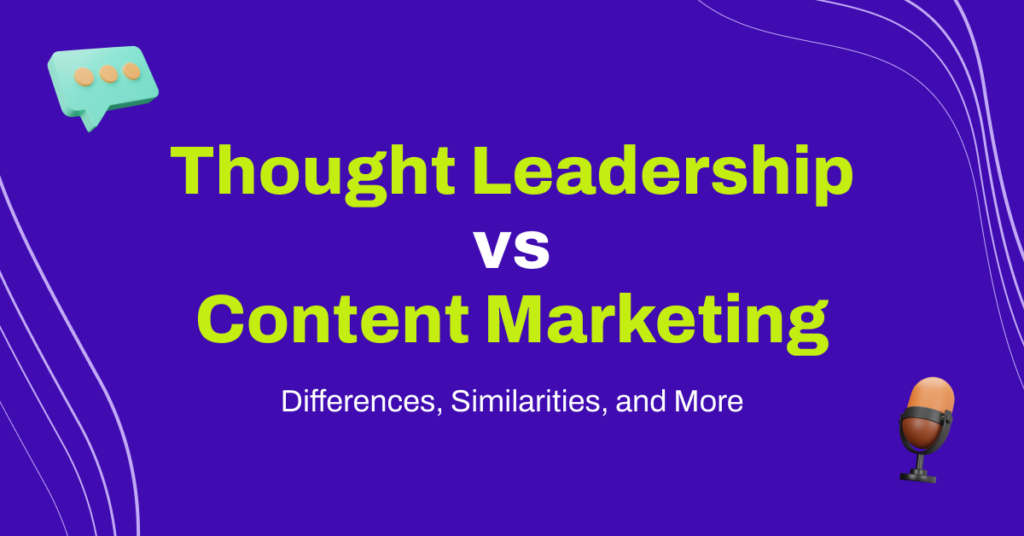Table of Contents

Authority scales when expertise comes first
Wordbrew helps teams collect expert insight before AI ever writes a word.
Built for expert-led, review-safe content
- Home
- »
- Content Marketing
- »
- Thought leadership vs content marketing: Differences, similarities, and more
-
Stacy Garrels
- 6 minutes read time
Thought leadership vs content marketing: Differences, similarities, and more
- Home
- »
- Content Marketing
- »
- Thought leadership vs content marketing: Differences, similarities, and more
Thought leadership vs content marketing: Differences, similarities, and more
Table of Contents

You are not imagining it. The marketing world is spinning faster than you can say “technological advancement.”
The good news, however, is that brands now have an abundance of tools and strategies at their disposal to attract and retain customers.
Two popular approaches you may have heard of are content marketing and thought leadership. While some people are aware of content and why they should create it, many aren’t sure which approach they should use and why.
The terms “content marketing” and “thought leadership” are often used interchangeably, but they have distinct differences. Content marketing is an umbrella term for creating and distributing valuable and relevant content to attract and retain an audience. On the flip side, thought leadership is about using that content to establish yourself as an authority in your industry by sharing your expertise and opinions.
In this article, we will explore the differences between these two approaches, and which is best suited to your business needs.
TL;DR:
- Content marketing is about creating valuable content to attract and retain an audience, while thought leadership is about positioning yourself as an authority in your industry.
- Measuring the effectiveness of thought leadership is focused almost exclusively on engagement, while content marketing relies on several metrics including reach, engagement, and conversion rates.
- Thought leadership helps your brand to stand out from the crowd and build trust with potential customers by sharing fresh perspectives and exhibiting expertise.
- Thought leadership content can also drive innovation and growth, boost profitability, and help people bounce back from hard times.
- To create thought leadership content, understand your target audience, diversify your channels, and don’t be afraid to turn to experts.
Thought Leadership vs. Content Marketing: Which One Should You Use?
So, you’ve got a fantastic product or service, but how do you get people interested? Two terms you’ve probably heard are “thought leadership” and “content marketing.”
Let’s get to the bottom of what they actually mean.
Content marketing is all about creating and distributing relevant, informative content to attract and retain an audience. Think blog posts, videos, and social media – anything that piques people’s interest in what you do.
Meanwhile, thought leadership is about establishing yourself as an authority in your industry. You must know what you are talking about, front to back, inside and out. For example, you might offer your unique perspective on industry trends or speak up on common pain points to showcase your expertise. This builds a reputation around your brand, which forges connections and trust with potential customers.
Deciding which approach would work best for you depends entirely on your goals. Content marketing is about leading prospects down a funnel and converting them into customers, whereas thought leadership shows the world that you are an authority in your field.
| Content Marketing | Thought Leadership | |
| What is it? | The part of a marketing strategy that involves creating content. | A component of content marketing that helps establish an individual or brand as an authority in their field. |
| What does it do? | Attracts potential leads and converts them to customers. | Builds a reputation and creates connections with potential customers. |
| What can it achieve? | Increased traffic and leads. | Enhanced credibility. |
| What are the keys to success? | Quality, clear target audience, and content optimization. | The same as content marketing, but with more time, effort, and exclusive expertise. |
How Do You Measure Content Marketing and Thought Leadership?
To measure the effectiveness of your marketing campaigns, it’s essential to pick the right metrics.
For content marketing, the key lies in understanding how many people see and interact with your content. This is easily trackable with metrics like impressions, clicks, and scroll depth. Meanwhile, conversion rates can also shed light on how effective the content is at generating leads and driving sales.

In contrast, measuring thought leadership is primarily centered around engagement. Since thought leadership content aims to build trust and relationships with potential customers, metrics such as comments, social media interactions, and shares can show how well it’s resonating with the audience. In short, these metrics help businesses understand how much their content is being talked about and how much influence it’s having in the industry.
While measuring effectiveness can be complex, it’s worth considering both quantitative and qualitative data to see the whole picture. Depending on your goals, other indicators may be relevant, such as brand awareness and positioning. By analyzing these metrics, brands can make data-driven decisions that lead to greater success and impact.
Why Should Thought Leadership Be Part of Your Content Marketing Efforts?
One thing to note is that the pandemic has changed content consumption habits dramatically, with consumers increasingly seeking valuable educational content over traditional sales pitches. According to a report by the Content Marketing Institute, 80% of B2B marketers report success in achieving brand awareness, with 75% saying it builds credibility/trust and 70% saying their content marketing educates audiences. This means there’s a growing appetite for informational content –– providing the perfect environment for thought leaders to blossom.
In a crowded digital world, standing out is crucial. You need to provide unique insights and value to set yourself apart from the competition. That’s where thought leadership comes in: showing your unique expertise and sharing uncommon perspectives are refreshing for potential customers, making you memorable and trustworthy.
If you have the resources, pursuing a thought leadership strategy is a worthwhile investment. You can write blog posts, share wisdom on social media, and potentially even make speaking engagements. Just remember, it’s the long game, and it pays off in the end by building your brand, attracting new customers, and ultimately driving business success.

How Do Companies Benefit From Thought Leadership?
Half a blog post later, you have probably already gathered that thought leadership helps you to establish your authority in an industry, which builds your brand, attracts new customers, and ultimately drives success. But how else can it boost your business?
1. It drives innovation and growth
By staying on top of industry trends and sharing your insights with others, you can cultivate a culture of inspiration and ambition within your business. This can help you stay ahead of competitors and adapt to changing market conditions.
2. It boosts profitability
Being a well-known thought leader can lead to higher-than-average margins as businesses feel more confident in their value-based pricing. In turn, this shortens the sales cycle and strengthens customer relationships. Hello, internal efficiency!
3. It helps you bounce back from hard times
Thought leadership can be especially beneficial during economic downturns, right when the market needs fresh ideas and new approaches. As a result, the companies that usually make it through a recession best are the ones that can pivot with creativity and innovation.
How Should You Approach Thought Leadership Content?
The thought leadership vs content marketing debate shouldn’t bother you at all. Here are four steps to set you well on your way to creating effective content:
- Ensure you have a deep understanding of your industry and its trends
You should stay up-to-date with the latest developments and innovations, attend conferences and events where possible, and network with other industry experts. You should also identify your unique perspectives and insights that can add value for your audience.
- Create high-quality content that showcases your expertise
This content can take the form of blog posts, whitepapers, videos, podcasts, or social media. It should be well-researched, informative, and engaging, but don’t forget to diversify; switch it up between different mediums to reach a wider audience and cater to different preferences and learning styles. Here are some more thought leadership content examples for you.
- Build your personal brand
Help boost reputation by giving it a brand, and then give that brand a voice! Engage with your audience, network with other thought leaders, and participate in industry conversations.
- Measure your impact
Be sure to keep track of engagement to see how your audiences are responding.
Starting your thought leadership journey can be overwhelming! If you think you have what it takes but require some expert guidance, check out Wizeo. Our tips, tricks, and carefully crafted authority content helps you 10X your impact without investing significant time and resources.
FAQs
- Is thought leadership part of content marketing?
It sure is! Both thought leadership and content marketing require creating content that is informative, engaging, and helpful to the target audience. But they have different objectives.
Content marketing is a broad term that refers to attracting audiences through content. Thought leadership works similarly, but more to position an individual or organization as a reliable expert in a particular field.
- What is an example of thought leadership?
An example of thought leadership would be a CEO writing a blog post on industry trends, offering a unique perspective, and demonstrating expertise. - What does a thought leader do?
Thought leaders provide new ideas and insights, offer distinct perspectives, and establish themselves as an authority in their industry, ultimately building trust with their audience.
